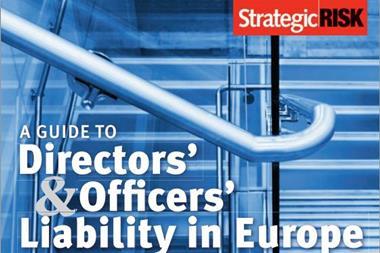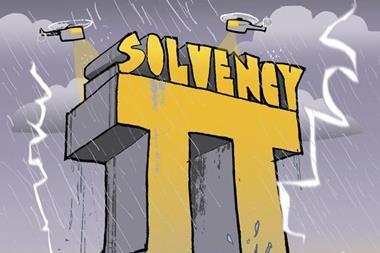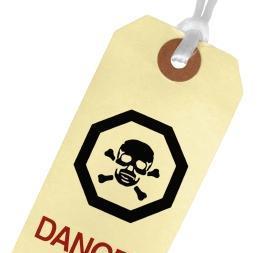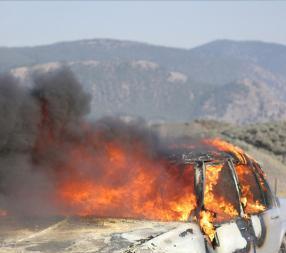A company which suffered not only a boardroom power struggle resulting in the early departure of the chairman, but ill-judged sales prospects, profits warnings and a book loss of £376.7m on the disposal of one asset and collapse of the sale of another, might be thought to have some risk management issues.
In 1994, leading UK retailer (and now also financial services provider) Marks & Spencer (M&S) was chosen by 637 of its peers as having the most admired management in Europe. Its near-iconic status as supplier of the nation's underwear simply increased the coverage when the management started to go wrong. It took the new management, led by chairman Luc Vandevelde, two years and a major overhaul of the company's business strategy to restore its prospects, but concern still remains that market conditions may weaken the recovery.
Like other UK public companies, M&S has a risk management statement in its annual report, in order to comply with the combined code guidance for directors produced by the Turnbull working party. The statement in the report and accounts for the financial year to 31 March 2002, the most recent available, confines itself to the process and internal communication of risk.
With the exception of financial risks, as mandated by the accounting guideline FRS 13, and a planned corporate social responsibility report (CSR), M&S does not discuss the nature of its risks in its annual report, nor was it willing to elaborate informally in response to our questions. Investors are left to make up their own minds whether there are other risks which could materially affect the performance of the company. The effectiveness or otherwise of the stated risk management policy and procedures has to emerge in retrospect.
This gap in explanation between procedure and substance contrasts with the requirements and practice in the US (although fear of D&O litigation is likely to be a stronger motives there than in the UK). For example, GAP Inc., which is also a major retailer, describes its business risks in some detail in its 10-K annual statement to the Securities and Exchange Commission (SEC) – an easily available public document.
Many of these risks, such as supply chain management, are relevant to M&S. However, it is often difficult to draw a clear line between risk disclosure and shareholder value. GAP, too, has had its problems. An investor who put $1000 into GAP in July 1999 would have only $320 worth of shares in April 2003. The holder of M&S would still have a loss, but the value of the shares would be $760.
GAP begins by discussing a number of fairly obvious issues. It must gauge fashion trends and changing consumer preferences. The business is highly competitive and depends on consumer spending patterns. Downgrades in credit ratings could have a negative impact on financing costs and structure in future periods.
However, the company then discusses planned changes to the IT systems that support its product supply line, where modifications may involve replacing legacy systems with successor systems. It explains: 'We are aware of inherent risks associated with replacing these core systems, including accurately capturing data and supply chain disruptions, and believe we are taking appropriate action to mitigate the risks through testing, training and staging implementation.
'We anticipate that the launch of these successor systems will take place in a phased approach over an approximate five-year period which began in 2002. There can be no assurances that we will successfully launch these new systems as planned or that they will occur without supply chain disruptions. Any resulting supply chain disruptions could have a material adverse effect on our operations.'
Better risk reporting
In the UK, according to Robert Hodgkinson, technical director of the Institute of Chartered Accountants in England and Wales (ICAEW), this level of disclosure tends to be confined to an offer prospectus and is not usually detailed in regular reports to shareholders and other stakeholders.
The ICAEW has been promoting better risk reporting for the last five years through publications such as No surprises – The case for better risk reporting, which appeared in July 1999. Their aim, said the ICAEW, was to help listed companies obtain capital at the lowest possible cost. By providing reassurance to potential investors, clearer disclosure of risk would help .
Many businesses did not agree. Among them was M&S. The company's then finance director, Robert Colvill, submitted this comment to the ICAEW: 'We do not agree with the assertion that the reporting of risk would reduce the cost of capital. The financial community, particularly analysts and institutional investors, already has a good understanding of the risks faced by individual companies and an appreciation of how these risks are managed.'
Colvill's comments date from March 1998, a time when the M&S share price was more buoyant than its future business prospects deserved. Peter Hutton, deputy managing director of the market research organisation MORI, says its research found that customers' ratings of the company's value for money and overall service levels had begun to fall three years before Colvill's confident statement. Hutton said: "It appears that many customers remained loyal to the company, even though they were going off it, in the same way you remain loyal to an old friend who never returns your hospitality or makes an effort on your behalf. But eventually they decided that what the company was offering and what they wanted had drifted apart. It is a salutary lesson. But it is not a new lesson."
In one area M&S has since decided to increase its reporting – issues related to the social, environmental and ethical effects of its activities or CSR. The 2001 annual report states: 'The group's risk assessment process is applied to identify the key risks in areas of employment policy, ethical trading, environmental management, animal welfare, health and safety and community involvement.' In June 2003, the company plans to publish a CSR report.
This report is bound to feature the strong food safety and welfare policies which M&S has adopted. For example, since 1996, M&S and a number of its suppliers have sponsored a chair of farm animal health, food science and food safety at Cambridge. In 2002, the leading animal welfare group, Compassion in World Farming (CIWF) chose M&S as its 'Compassionate Supermarket of the year'.
However, neither M&S nor competitors such as Tesco and J. Sainsbury, identify food safety risk in their risk management statement, even though it is an issue that can affect shareholder value, as reaction to reports – eventually discounted – of contamination of Coca-Cola in Belgium in August 1999 showed. M&S equipment supplier, Forster Refrigeration, comments on its web site: 'Nothing is as important to the caterer as food safety.'
Likely developments
Companies will come under increasing pressure from auditors and accountants to disclose more information about the risks they face and how they manage them.
Recommendations for disclosure of risk outside financial statements have been in place for listed companies for ten years, ever since the Accounting Standards Board (ASB) introduced the operating and financial review in annual reports in 1993. This recommends a discussion 'identifying the principal risks, and, in qualitative terms, the nature of the potential impact on results'.
These recommendations are not mandatory and have not produced the results that the ICAEW would like. It believes that for investors to understand the potential for future cash flows in the business properly, they need an understanding of the risks it undertakes.
The Turnbull report said directors should establish a continuing process for identifying, evaluating and managing the company's material risks and state as much in the annual report. Says Robert Hodgkinson: "The missing piece of the combined code and Turnbull is disclosure." He indicates that the operating and financial review is likely to become "a lot more demanding" in its risk disclosure requirements.
In June 2002, the ICAEW followed up with a further report: No surprises – working for better risk reporting. This says that investors need an analysis of the risks affecting the company's business, what measures are applied to quantifying them and what steps the company takes to manage them.
The ICEAW recommends:
Better information about what companies assess and how they manage key business risks, says the report, should provide practical, forward looking information, reduce the cost of capital, encourage better risk management and improve accountability for stewardship, investor protection and the usefulness of financial reporting.
'We do not think that misgivings about directors' legal liability and commercial sensitivity are well founded. It is realistic for listed companies to aspire, at a minimum, to maintaining prospectus standards of risk disclosure in their annual reports. Companies that are listed because they need access to new capital should not object to keeping investors fully informed,' states the ICAEW.
Companies like M&S are not expected to anticipate and report every possible eventuality that might affect the business. But what they can do is demonstrate that they have identified the risks that they face in the broad sense and have taken measures to manage the impact on the business.
As the ICAEW points out: 'Enterprises in the same industry, facing similar risks, will often choose different risk management actions, because different managements have different risk strategies, objectives and tolerances. It is, therefore, important that investors are made aware of the key business risks and how each risk is managed rather than given simply an assessment of the net risk."
The ICAEW papers are available at www.icaew.co.uk
Lee Coppack is editor of Catastrophe Risk Management, a sister publication to Strategic Risk. Email: lee@coppack.co.uk



















